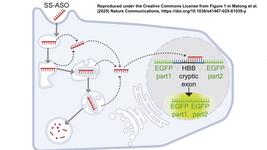CMN Weekly (2 June 2023) - Your Weekly CRISPR Medicine News
By: Gorm Palmgren - Jun. 2, 2023
Top picks
- American and Japanese researchers have presented an encouraging dual stem cell tumour-targeting therapy for brain-metastatic melanoma. The novel treatment includes two stem cells, one of which is gene-edited to acquire resistance to oHSV and release beneficial immunomodulators via CRISPR-Cas9-mediated knockout of the nectin 1 receptor. The team found that local delivery of the novel therapy could treat both syngeneic and patient-derived humanised mouse models of brain-metastatic melanoma.
- CRISPR-GRANT is a new cross-platform graphical analysis tool for high-throughput CRISPR-based genome editing evaluation. It offers a straightforward GUI by simple click-and-run for genome editing analysis of single or pooled amplicons and one-step analysis for whole-genome sequencing without data pre-processing, making it ideal for novice lab scientists. CRISPR-GRANT is a valuable addition to the current CRISPR toolkits, significantly lowering the barrier for wet-lab researchers to conduct indel analysis from large NGS datasets.
Research
- Spanish researchers have developed CRISPR-Analytics, CRISPR-A, a comprehensive and versatile genome editing web application tool and a next-flow pipeline to support gene editing experimental design and analysis. CRISPR-A is ideal for supporting multiple kinds of experiments, such as double-stranded DNA break-based engineering, base editing (BE), primer editing (PE), and homology-directed repair (HDR) without the need to specify the used experimental approach.
- Researchers in China have discovered that a synergistic incorporation of two short ssDNA activators (but not a single one) can promote the trans-cleavage of CRISPR-Cas12a. As a proof-of-concept, the system has been successfully harnessed in the AND logic operation and the discrimination of single-nucleotide variants, requiring no signal conversion elements or other amplified enzymes.
- Stem cell therapies are promising therapies to treat degenerative disc disease (DDD), but the acidic environment in a degenerating disc significantly hinders the viability of stem cells, affecting their efficacy. Now, researchers in the US have used CRISPR to engineer desirable cell phenotypes to improve cell viability for the potential treatment of DDD that expose cell therapies to acidic environments.
Industry
- SNIPR Biome reports positive clinical interim results for groundbreaking, first-in-human, CRISPR-based microbial gene therapy, SNIPR001 - the first CRISPR-armed phage therapeutic developed to specifically target and remove E. coli, including antibiotic-resistant strains, from the human gastrointestinal tract. The study, with 36 healthy individuals across three dose levels of SNIPR001, demonstrates clinical proof of principle for this new technology, and future studies are now being planned to evaluate the impact of SNIPR001 on reducing the rate of infections in cancer patients at high risk of E. coli gut translocation into the bloodstream.
- The global cell therapy market size attained a value of $13.8 billion in 2022, according to a market report from ResearchAndMarkets.com. The cell therapy market is experiencing significant growth of 18.1% annually, driven by the increasing prevalence of chronic diseases, genetic disorders, and advancements in biotechnology.
Detection
- A new platform for point-of-care detection of Neisseria gonorrhoeae is based on RPA-CRISPR-Cas12a. In evaluating 24 clinical samples, the detection system demonstrates a 100% concordance rate with traditional culture, which is used clinically as a reference method.
- A new HIV-1 Cas13 assay utilises a Self-digitization Through Automated Membrane-based Partitioning (STAMP) method to digitalise the CRISPR-Cas13 assay (dCRISPR) for amplification-free and absolute quantification of HIV-1 viral RNAs. The device has a detection limit of approximately 2000 copies/mL and can resolve a viral load change of 3571 copies/mL with 90% confidence.
- Chinese scientists have developed a dual-enzyme cascade amplification strategy based on CRISPR-Cas12a and glucose oxidase (GOx) for instrument-free and sensitive detection of target analytes. The target directly initiates CRISPR-Cas12a-based signal transduction, resulting in the enzymatic cleavage of the ssDNA linker and the release of GOx from magnetic nanoparticles.
- Researchers in China describe an immunocapture magnetic bead-enhanced electrochemical biosensor for ultrasensitive SARS-CoV-2 detection based on CRISPR-Cas13a technology. The biosensor required approximately one h of overall processing time and demonstrated an ultrasensitive ability to detect SARS-CoV-2, which could be as low as 1.66 aM.
Reviews and commentaries
- Advances in stem cell and other therapies for Huntington's disease: An update. This review summarises the recent research on stem cells, genetic modifications, and organoids as potential for treating HD.
- The history of genome editing: advances from the interface of chemistry & biology. This review covers the history of genome editing and improvements in genome editing tools. It provides examples of genome editing tools applied in basic sciences, the bio-industry, and therapeutics to various tasks.
- CRISPR-Cas9 in hiPSCs: A new era in personalised treatment for Stargardt disease. Inherited retinal dystrophies, including Stargardt disease, are a group of genetic eye diseases that currently lack adequate treatment options. A recent study demonstrated the accurate correction of two pathogenic variants in the ABCA4 gene, which triggers Stargardt disease, in hiPSCs without any adverse effects.
Meetings and webinars
- The CRISPR Conference 2023 will occur in Würzburg, Germany, on June 27-July 1. The scientific program will cover various aspects of CRISPR biology, including genetics, biochemistry, structural biology, ecology, evolution, and applications.
- CRISPR Medicine News hosted a webinar on June 12 entitled Clinical-Grade gRNA for Genomic Medicines: Making Sense of the CRISPR Regulatory Landscape. In this webinar, Synthego's Senior Director of Quality & Regulatory, Beckinam Nowatzke, and Senior Regulatory Specialist, Lina Jamis, will elaborate on Synthego's preclinical offerings in support of CRISPR therapy developers and an interpretation of FDA's expectations for CRISPR gene editing components.
News from CRISPR Medicine News
- In a clinical update on Wednesday, we brought the news that the Danish company SNIPR Biome announced positive interim clinical results from its Phase 1 clinical trial of SNIPR001. SNIPR001 is the first CRISPR-armed phage therapy developed to target and eradicate E. coli, including antibiotic-resistant strains, from the human gastrointestinal tract.
To get more of the CRISPR Medicine News delivered to your inbox, sign up to the free weekly CMN Newsletter here.
Tags
CLINICAL TRIALS
IND Enabling
Phase I
Phase II
Phase III
Recurrent or Progressive High-grade Glioma, (NCT06737146)
Sponsors:
Suzhou Maximum Bio-tech Co., Ltd.
Sponsors:
Suzhou Maximum Bio-tech Co., Ltd.
IND Enabling
Phase I
Phase II
Phase III
Advanced Peritoneal Malignancies or Abdominal Metastatic Solid Tumors, (NCT06912152)
Sponsors:
Zhejiang University
Sponsors:
Zhejiang University
IND Enabling
Phase I
Phase II
Phase III







